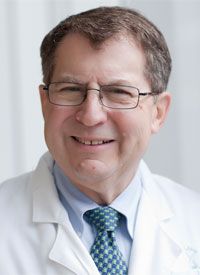Certain Breast Cancer Patients Find Endocrine Therapy Ideal
Tumor reduction for patients with ER-positive breast cancer can be achieved with endocrine therapy and can possibly avoid the need for chemotherapy or even surgery in some patients. Hyman B. Muss, MD, who presented at the 2018 Miami Breast Cancer Conference, said that deciding how long to continue this therapy can be tricky, however.
Hyman B. Muss, MD

Hyman B. Muss, MD
Tumor reduction for patients with ER-positive breast cancer can be achieved with endocrine therapy and can possibly avoid the need for chemotherapy or even surgery in some patients. Hyman B. Muss, MD, who presented at the 2018 Miami Breast Cancer Conference, said that deciding how long to continue this therapy can be tricky, however.
“It can improve the probability of breast preservation for women who would appropriately fit in [related] studies and don’t have very high-grade or aggressive tumors,” said Muss, of the Lineberger Comprehensive Cancer Center, University of North Carolina, and a 2017 Giants of Cancer Care winner. “The optimal duration is 3 to 6 months. I think it’s [also] worth considering this in postmenopausal women with larger tumors.”
“A lot of studies compare primary treatment with drugslike tamoxifen—with surgery in operable candidates, and suffice it to say that now, with long-term data, although surgery is better for controlling local disease, overall survival is the same,” Muss added.
He also said that not only is endocrine therapy potentially very helpful in shrinking tumors, it’s also very effective as adjuvant therapy.
The current National Comprehensive Cancer Network guidelines indicate that preoperative endocrine therapy alone may be considered for patients with ER-positive disease, based on available data on comorbidities or low-risk luminal status.
One randomized phase II trial found that neoadjuvant endocrine therapy showed similar efficacy as chemotherapy in 239 patients.1A partial response (PR) was achieved in about 65% of patients in both groups and 10% had no palpable mass, There was no significant difference statistically between the groups. “And these are all stage 2B, 3B, and 3A patients,” Muss explained further.
In terms of breast conservation, data seemed to favor endocrine therapy (33% vs 24%). The pathological complete response (pCR) percentages were low6% for endocrine therapy versus 3% for chemotherapy—but Muss stated, “very few of these patients get pCRs. When I talk about neoadjuvant and endocrine therapy in hormone receptorpositive patients, I don’t build up the pCR as such an important thing, because then when you don’t get it, patients are petrified."
It’s usually unclear how much preoperative endocrine therapy should be used before using a more aggressive treatment.
“The real question on thisthe frequently asked question—is if you do it, how long should you give it, and how will you know when to bail out early?” Muss said.
A study co-authored by Michael J. Dixon, MD,2could help answer the duration question, Muss noted. The clinical complete response (CR) and partial response (PR) rates at 3 months in the 182-patient trial were 70% with neoadjuvant letrozole. 63 patients elected to continue letrozole after 3 months. These patients achieved an 84% CR+PR rate. 33 women at a mean age of 83 years remained on letrozole. At 3 years, median time to treatment failure had not been reached.
“A lot of older people did great on this neoadjuvant therapy and then stayed on it without surgery, so I would say that you need at least 3 to 4 months, but one of the seminal trials that we’re doing to help us with the chemotherapy question is 6 months. It’s tough for a lot of patients to take a little pill with a mass in their breast that they can feel and wait 6 months for surgery. You’ve got to cheer them along,” Muss stated.
Reported in a study in 2008, the Preoperative Endocrine Prognostic Index (PEPI) was used to determine how relapse risk could help with decisions regarding additional treatment options for patients who have received neoadjuvant endocrine therapy.3Patients with breast cancer with pathological stage 1 or 0 disease and a PEPI score of 0 were at very low risk of relapse and unlikely to benefit from adjuvant chemotherapy, investigators concluded.
“They looked at relapsed survival at 5 years and these data were very impressive by the PEPI scores. But very few of these patients had pCR, pathologically, so it’s a very skewed group, but this scoring system worked impressively well,” Muss said. PEPI, Allred, and Ki67 scoring results demonstrate that “you don’t have to rush. If you have these grade-1, hormone-receptive tumors, they’re more likely to respond, and this is verified by genomic assays and other assays.”
References:
- Semiglazov VF, Semiglazov VV, Dashyan GA, et al. Phase 2 randomized trial of primary endocrine therapy versus chemotherapy in postmenopausal patients with estrogen receptor-positive breast cancer. Cancer. 2007;110(2):244-254. doi: 10.1002/cncr.22789.
- Dixon JM, Renshaw L, Macaskill EJ, et al. Increase in response rate by prolonged treatment with neoadjuvant letrozole. Breast Cancer Res Treat. 2009;113(1):145-151. doi: 10.1007/s10549-008-9915-6.
- Ellis MJ, Tao Y, Luo J, A'Hern R. Outcome prediction for estrogen receptor-positive breast cancer based on postneoadjuvant endocrine therapy tumor characteristics. J Natl Cancer Inst. 2008;100(19):1380-1388. doi: 10.1093/jnci/djn309.